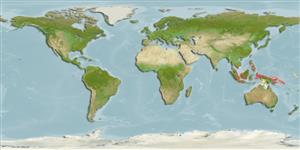Teleostei (teleosts) >
Perciformes/Scorpaenoidei (Scorpionfishes) >
Scorpaenidae (Scorpionfishes or rockfishes) > Pteroinae
Etymology: Pterois: Greek, pteron = wing, fin (Ref. 45335); andover: Named for the Andover group of companies, dedicated to promoting greater public appreciation of the oceans and marine conservation in Asia; noun in apposition.
Eponymy: Named after the Andover group of companies: “…dedicated to promoting greater public appreciation of the oceans and marine conservation in Asia.” (Ref. 128868), visit book page.
Environment: milieu / climate zone / depth range / distribution range
Ecology
Marine; benthopelagic; depth range 3 - 70 m (Ref. 74961). Tropical
Western Pacific: Indonesia and Papua New Guinea; also expected from the East Indian region, Sabah and the Philippines.
Size / Weight / Age
Maturity: Lm ? range ? - ? cm
Max length : 23.0 cm TL male/unsexed; (Ref. 90102); 16.8 cm SL (female)
Short description
Identification keys | Morphology | Morphometrics
Dorsal spines (total): 13; Dorsal soft rays (total): 11; Anal spines: 3; Anal soft rays: 7. This species is distinguished by the following characters: D XIII,11; A III,7; pectoral rays 12-14 (usually 13); vertical scale rows in longitudinal scale series 62-72; horizontal scale rows above lateral line 9-10; below lateral line 13-15; dorsal spines with narrow, inconspicuous membrane on posterior edge with exaggerated pennant-like flap distally; relatively few dark spots on median fins, 5-28 on dorsal fin, 10-19 on anal fin, and 17-41 on caudal fin; first dorsal spine is relatively short, with an average length of 14.95% of SL (Ref. 74961).
Occurs on or near turbid inshore reefs surrounded by soft sand-mud bottoms, often in the proximity of freshwater discharge (Ref. 74961).
Life cycle and mating behavior
Maturity | Reproduction | Spawning | Eggs | Fecundity | Larvae
Allen, G.R. and M.V. Erdmann, 2008. Pterois andover, a new species of scorpionfish (Pisces: Scorpaenidae) from Indonesia and Papua New Guinea. aqua, Int. J. Ichthyol. 13(3-4):127-138. (Ref. 74961)
IUCN Red List Status (Ref. 130435: Version 2024-1)
Threat to humans
Harmless
Human uses
Fisheries: of potential interest
Tools
Special reports
Download XML
Internet sources
Estimates based on models
Preferred temperature (Ref.
123201): 27.5 - 29, mean 28.2 °C (based on 34 cells).
Phylogenetic diversity index (Ref.
82804): PD
50 = 0.5005 [Uniqueness, from 0.5 = low to 2.0 = high].
Bayesian length-weight: a=0.01000 (0.00440 - 0.02274), b=3.02 (2.83 - 3.21), in cm total length, based on LWR estimates for this (Sub)family-body shape (Ref.
93245).
Trophic level (Ref.
69278): 3.9 ±0.6 se; based on size and trophs of closest relatives
Resilience (Ref.
120179): Medium, minimum population doubling time 1.4 - 4.4 years (Preliminary K or Fecundity.).
Fishing Vulnerability (Ref.
59153): Low vulnerability (13 of 100).
